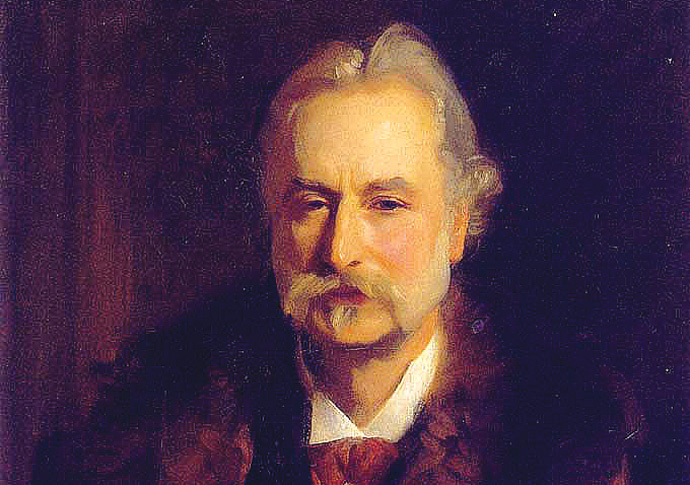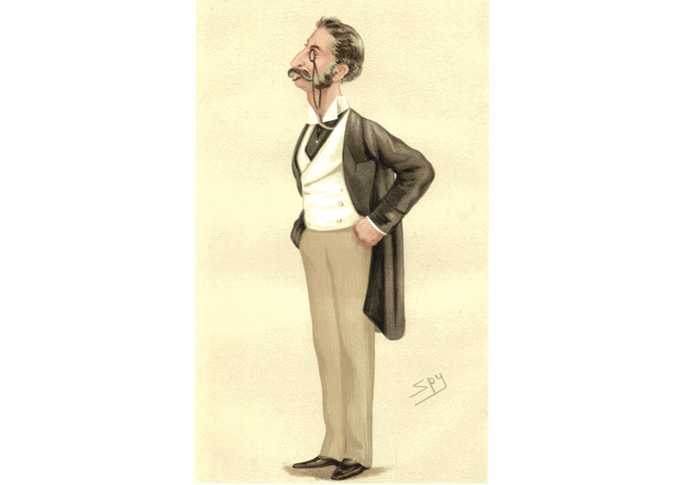Society’s Holmes
In the latest in his series about eminent Camden Victorians, Neil Titley turns his attention to the incorruptible Sir George Lewis
Thursday, 16th November 2023 — By Neil Titley

George Lewis as portrayed by John Singer Sargent
SOME years back, Britain was agog with the news that an elderly gang had pulled off what came to be known as “the Hatton Garden Job” – a crime caper that replicated a similar event of Victorian times. The “Hatton Garden Diamond Robbery” of 1882 resulted in the arrest of the culprits in Paris and Brussels and their prosecution by arguably the most famous lawyer of his day.
George Lewis (1833-1911) was born just around the corner from the scene of the heist at
10 Ely Place, Holborn – close to the existing Old Mitre tavern. He came from a family of lawyers and his father James Lewis was said to have inspired the character of Mr Jaggers in Charles Dickens’ Great Expectations.
Described as looking like a “Jewish Voltaire”, Lewis liked to emphasise his image by always being seen in a long fur coat and monocle. It became a tradition to dress The Solicitor in Gilbert and Sullivan’s Trial by Jury to resemble Lewis.
His other outstanding feature was that he was incorruptible. “A man whose only vice was a liking for good cigars could not be got at.”
Despite being a superb prosecutor, Lewis mostly worked as a solicitor, saying that it was often the solicitor who controls the case rather than the barrister. His real gift was his ability to persuade parties that matters were best settled by keeping them out of the courtroom.
However, once negotiation failed Lewis was a bulldog. He was known to play a rough game and relied on a team of private spies and informers, mainly recruited from the ranks of professional criminals who he had successfully defended. He believed in the principle “My client, right or wrong”, and a legal observer commented that Lewis made “the processes of Sherlock Holmes seem like the efforts of a beginner”.
Although he triumphed in many legal arenas, in particular exposing the practices of usurious money-lenders, his greatest skill lay handling the labyrinthine affairs of the upper classes. Known as “Society’s Solicitor”, his array of noted clients included Ellen Terry, Mrs Patrick Campbell, Lillie Langtry and Jennie Churchill, and it was his foresight that guided the Prince of Wales through several embarrassing entanglements. The artist Edward Burne-Jones said that: “Lewis knew enough to hang half the Dukes and Duchesses in the kingdom”.
However, he was not simply high society’s guide dog and certainly had no qualms when it came to upsetting powerful political forces.

George Lewis as portrayed by Vanity Fair
In 1887, in an attempt to ruin the Irish leader Charles Stuart Parnell, the Times newspaper published letters allegedly written by him and showing support for a Fenian assassination campaign. Parnell indignantly dismissed the letter as a forgery and enlisted Lewis to sue the Times for libel. During the trial, Lewis broke down the main defence witness, one Richard Pigott, who was forced to confess that he had forged the letters. A Special Commission later exonerated Parnell.
In 1893, the Prince of Wales insisted that Lewis, despite his relatively humble profession, should receive a knighthood. For 30 years Sir George and Lady Lewis regularly opened their Portland Place home to gatherings where the Establishment, the Arts, and Bohemia were encouraged to mix. As a result they presided over some of the most glamorous parties in London.
In particular they welcomed visiting musicians such as Anton Rubenstein and Ignace Paderewski.
Paderewski’s first ever recital in a private home was at Portland Place. It was indeed a period of great enthusiasm for foreign pianists in London. As Oscar Wilde put it: “Even those that are born in England become foreigners after a time.”
Possibly George Lewis’s most famous involvement was in the Archer-Shee trial of 1909 – this gained fame when it became the basis of Terence Rattigan’s play The Winslow Boy, later filmed in 1948 starring Robert Donat and Margaret Leighton, (also in 1999 starring Jeremy Northam and Gemma Jones).
The case concerned a 13-year-old cadet called George Archer-Shee who while attending the Royal Naval College at Osborne had been accused of stealing a five-shilling postal order and expelled from the college.
His family, convinced of his innocence, asked Lewis to bring in the renowned advocate (and Wilde’s nemesis) Sir Edward Carson to fight on their behalf.
It became a cause célèbre that captured the attention of the nation and, in a highly charged atmosphere, Carson finally won the case against the Admiralty and vindicated the boy.
Carson was not normally a demonstrative man but when amid the cheers of the spectators he rose to leave the court, tears were streaming down his face.
Sadly the young naval cadet was killed at the First Battle of Ypres in the First World War. He was aged just 19.
Always the epitome of discretion, on his retirement in 1909, Lewis burned all his papers. As the Prince of Wales said of him: “George Lewis is the one man in England who should write his memoirs – and of course he never can.”
• Adapted from Neil Titley’s book The Oscar Wilde World of Gossip. For more details go to www.wildetheatre.co.uk New deluxe and revised American edition at uniexna.com